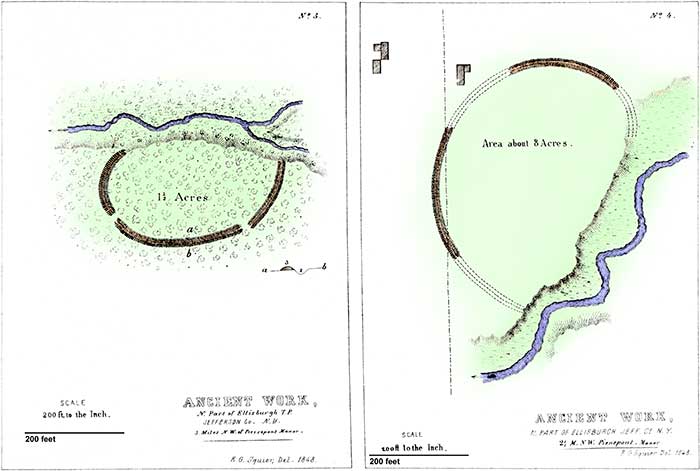
PLATE IV. Nos. 3 and 4.
ANCIENT WORKS IN ELLISBURGH TOWNSHIP, JEFFERSON COUNTY, NEW YORK.
A NUMBER of ancient works formerly existed in Ellisburgh, one of the southern towns of the county. Plate IV., No. 3, is one of those which are yet perfect. It presents no novel features, is protected in the usual manner, and has the usual relics and traces of occupancy within its walls. Three quarters of a mile to the eastward is another similar, but larger work (Plate IV., No. 4), which has been very nearly obliterated by the plough. The sections indicated in the engraving are yet quite distinct; nor can the parts supplied differ very materially from the original lines. Perhaps no work in the State has more decided evidences of aboriginal occupation. The entire area is covered with traces of ancient habitations, and with relics of art,—pottery, ornaments, and implements. Exterior to the walls, in all directions, but particularly on the level grounds between the two works, the same indications are abundant. Indeed, the artificial accumulations are so great as materially to augment the fertility of the soil. Caches have been observed here, in some of which the present proprietor of the grounds has found a number of bushels of parched corn, carbonized by long exposure. It is scattered over the surface, and may after rains be collected in considerable quantities. Here, too, have been found skeletons buried according to the usual custom.
The aboriginal population must have been very large at this spot, which, both in aspect of soil and the close proximity of springs and pure streams, affords a most beautiful site for an Indian village.
About a mile to the southward of this group, upon the land of Mr. Mendall, was another work, of which no trace now remains. Another occurred at a place called Clark's Settlement, still another at Ellis Settlement, and others in various parts of the township, concerning which no definite information can now be obtained.
Near the neat and pretty village of Pierrepoint's Manor, is also the site of an ancient town, undistinguishable from the fortified village already described, except by the absence of an embankment and trench. Large quantities of relics have been recovered here. A work of considerable size was visible until within a few years, half or three fourths of a mile northwest of the village of Adams, on the lands of Mr. W. Benton. It is described by Mr. Justus Eddy, in a letter to the author, as having been semicircular in form, five hundred feet in diameter, and the open segment facing or rather opening towards a marshy piece of ground, through which flowed a small stream. There were two or three breaks, or passage-ways, in the embankments. At the time of the settlement of this part of the country by the whites, about fifty years ago, trees two and three feet in diameter were growing upon the wall, and within the area. The embankment was then between three and four feet in height. Within the work were found quantities of pottery, pipes, and beads, covered with ornamental figures. A silver star-shaped ornament, bearing the initials P. H., was also found. It was quite thin, not exceeding the common sixpence in thickness.
Upon an island, outside of Sackett's Harbor, known as Snow-shoe Island, it is said, there are traces of an ancient work. So far as could be gathered, it was a palisaded structure, unaccompanied by an embankment.
Besides the various earth-works above described, there are a number of other interesting objects of antiquarian interest in this county. Among them may be mentioned the "bone-pits," or deposits of human bones. One is found near the village of Brownsville, on Black River. It is described as a pit, ten or twelve feet square, by perhaps four feet deep, in which are promiscuously heaped together a large number of human skeletons., It will be seen ultimately, that these accumulations owe their origin to a remarkable custom, common to many of the Indian tribes, of collecting and depositing together the bones of their dead, at stated intervals. Another pit, very unlike this, however, exists about three miles east of Watertown. It is situated upon the slope of a hill, and was originally marked by a number of large stones heaped over it. Upon removing these and excavating beneath them, a pit about six feet square, and four deep, was discovered, filled with human bones, all well preserved, but in fragments. Upwards of forty pairs of the patella were counted, showing that at least that number of skeletons had been deposited in the pit. It is said that the bones, when first exhumed, exhibited marks such as would result from the gnawing of wild animals; and from this circumstance, and the fact that they were so much broken up, it has been very plausibly supposed that these are the bones of some party which had been cut off by enemies, and whose remains were subsequently collected and buried by their friends. All the bones are those of adults. Many of the fragments have been removed and scattered, but several bushels yet remain. No relics of any kind were found with them.
A large mound is said to occur "about one mile from Washingtonville, and eleven from Adams, on a cross-road from the 'ridge road,' leading from Lamb's tavern to Washingtonville. It is conical in shape, and thirty feet high." It is questionable whether this is artificial.

